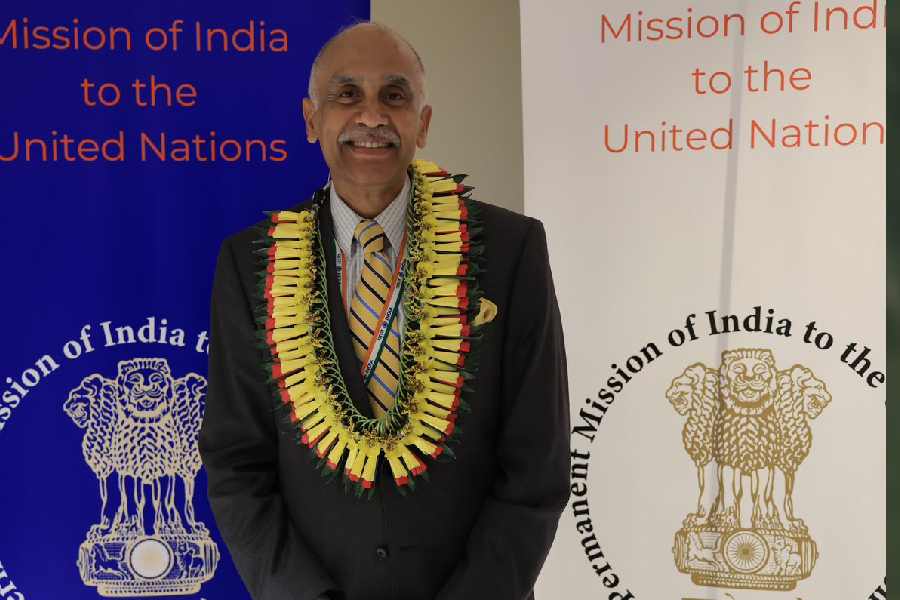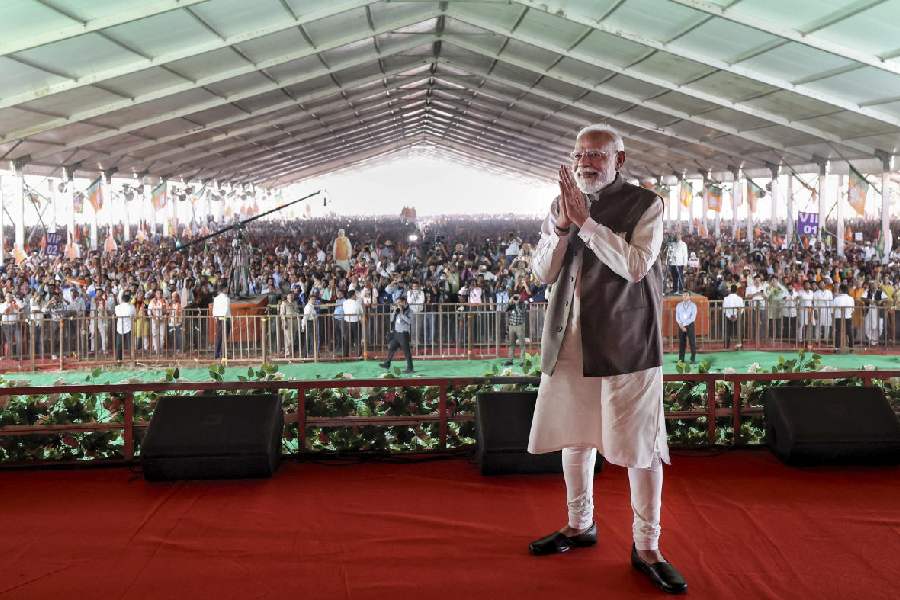 |
Of Love, Nature, And Devotion: Selected Songs of Rabindranath Tagore Translated and introduced by Kalpana Bardhan, Oxford, Rs 750
Listen to this. That is, speak the following lines out to yourself, instead of reading them silently on the page: “In the lap of clouds smiles the sun, the rain stopped. A-ha, ha-ha, ha!/ Today is our day off, friends, it’s our day off. A-ha, ha-ha, ha!/... With the cowherd boy we’ll graze cows, all day playing reed flutes,/ cover our bodies in pollen, rolling in the plumeria bosk. A-ha, ha-ha, ha!” And now to this: “Behind this separation of you and me/ How much more of bridging do I do…” Or this: “O my dear ones, all of you are nice —/ whose fate has delivered what, for us that’s nice…” Then this one too: “Is it only you always in this way to colour me up and run away?/ Won’t you, lord, wish to be held to take on your chest colour from me...” And finally, “In your dry creek now comes a high tide, say Joy Ma and launch the boat…. Day by day your debts have grown, Brothers, you didn’t do any transaction...”
If you are familiar with Rabindranath Tagore’s songs in Bengali, you must have figured out by now, possibly with a sinking feeling turning into desperate mirth, that these are some of Tagore’s most beautiful lyrics, rendered in a language that one would call English only at gun-point. (Without the gun, we might have hazarded ‘Bongo-Anglian’. But the publisher is OUP after all — and that, I suppose, is gun enough. Besides, the blurbs by Amartya Sen and Ashis Nandy are full of praise.) The first song is what every Bengali child learns in school, Megher kole rod heshechhe. (I have used, throughout, the transcriptions from Bengali provided by the translator.) To translate the richly wistful Tagorean word, chhuti, into “day off” is to turn the pastoral of childhood into a corporate picnic in Santiniketan. But isn’t “plumeria bosk” for champar bon matchless in its Jabberwocky nonsensicalness? The second bit is from the sublime Tomar aamar ei biroher auntorale, composed in Tagore’s late-middle years and situated in that twilight world between desire and worship. Yet “bridging do I do” conjures up, for me, a social butterfly in the Twenties (Shesher Kobita’s Kitty played by the young Kanan Debi in chiffon) whiling away the boredom of separation from her beau by gloomily playing bridge in Shillong. (Imagine a little space in the middle of the translator’s phonetic transcription, auntorale, and you have the Sadean Aunt Orale.) The impossibly jumbled-up syntax of the third sample, together with the stupefying banality of “nice”, translates Ogo, tomra shaubai bhalo. And the one after that comes from the middle of Aha, tomar shaunge praner khela, a lovesong again from the poet’s middle years. But asking the lord to “take on [one’s] chest colour” (aamar-o rong bokkhe niyo) is to introduce an element of erotic grotesquerie that pushes the play-world of the song in a bizarrely literal direction. Finally, to translate korli ne keu becha kena in Ebar tor maura gaange as “you didn’t do any transaction” is not only to write dreadful English, but also entirely to miss the self-consciously ‘folk’ register of a recreated boatsong. A sophisticated Modernist is trying to be a boatman and a patriot here.
Kalpana Bardhan taught economics at Berkeley and has translated Bengali fiction into English for several distinguished publishers. As documented in her introduction to this volume, her relationship with the emotional and melodic worlds of Rabindrasangeet is one of long and genuine engagement, or even immersion — as reader, listener, singer and eventually, “hummer”. It is also a pity that her translations of the 300-plus lyrics from Tagore’s 2,000-plus involved “nearly six years” of undoubtedly sincere and meticulous labour, avoiding what she considered to be the ‘softer’ and less satisfactory option of translating into poetically heightened prose or free verse. Bardhan went instead for the greater challenge of translating her selection “by following not only the words but also the structure of the words and phrases, line by line, as well as the rhyme pattern of the original as far as is possible”. This shows extraordinary courage and independence of mind, for, as her introduction points out, the Encyclopaedia Britannica finds the songs “virtually untranslatable” and, more important, Tagore himself “disapproved of all metrical translations and wanted his poems to be translated into lucid prose”.
Bardhan’s translations look identical to their originals on the page, replicating the latter’s caesurae, line and stanza divisions. As a result the superficial musical and metrical structures of each song are also ‘faithfully’ preserved, and I have even tried, with astonishing success, to sing the English versions in their original tunes. But if you try doing this with the specimens given above you will realize how profoundly disconcerting, even harrowing, that experience could be, if you happen to have even a tiny bit of an ear for poetry, or simply for grammatically correct, felicitous English. It is as if the Gitabitan has turned, all of a sudden, into a syntactically garbled Gilbert & Sullivan opera, rendered, however, with a mix of literalism, mawkishness and jumbled linguistic or cultural registers that is too entertaining in its sustained absurdity to make one seriously angry for long. I kept recalling that caricature of vernacular literalism, in which the idiomatic expression for covert action, dube dube jol khaoa, is translated as “sinking sinking drinking water”.
It cannot be denied that Bardhan’s is a labour of love. But this labour rests on a fundamentally misconceived notion of how one moves from one poetic language to another, what one holds on to and what one lets go of, where fidelity ends and originality begins (and vice versa). Bardhan’s basic historical scholarship is derived entirely from veteran Tagoreans like Prabhat Kumar Mukhopadhyay and Subhas Choudhury. But nowhere in her bibliography is Tagore’s great (and late) biographer, Prasanta Pal, mentioned. And among those in the West who had responded to Gitanjali, Bardhan lists, together with Gide and Pound, Matthew Arnold, who had died in 1888, more than two decades before the publication of the English Gitanjali. A little more learning and a modicum of literary sense, rather than love, would have served this translator better.










